Applying Sharps and Flats to Notes
Note Names:
We need to start the music theory sharps with the notes that are used in modern music. There are 7 basic note names. The 7 note names are:
These notes are repeated over and over again on the staff or a keyboard and modified for chord or scale conditions. We will use an octave of the keyboard to explore sharps and flats.
Note Sharps and Flats
There are 7 base note names can each also be called a sharp (#) or a flat (b). The sharps and flats are shown on the staff lines with these symbols.
Also note that the when you identify a sharp or flat that with in a measure if you what to go back to the natural note then you use the symbol (![]() ) here we how an example of this on the master staff. See where the natural sign was used? It took the B flat note and made it a B natural.
) here we how an example of this on the master staff. See where the natural sign was used? It took the B flat note and made it a B natural.
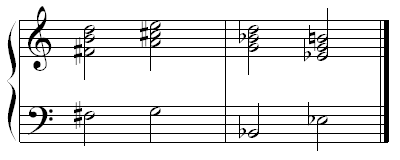
Here is also one thing to remember when you are moving from one measure to the next: A note that has been changed by a sharp or flat symbol will only last for that measure. It changes back to a natural note when once again seen in the next measure unless specifically changed by another symbol.
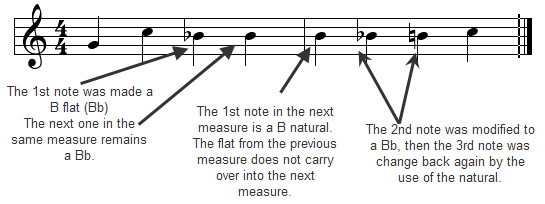
Key signatures also can make all notes for sharps or flats consistant for the whole song. The symbols will be at the first of the song and each line there after. So when you see this type of notation you know that all notes will be sharp or flat for those notes.
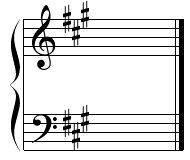
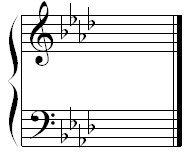
Here we take a look at the notes on a keyboard that commonly known as sharps and flats.
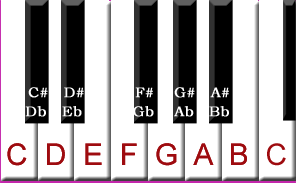
So how in music theory sharps and flats are defined or created? The simple way to look at this is to say a note is sharped by adding a half step up the scale, and a note will become flat when when go down a half step on the scale. Let’s take a closer look.
Sharps:
As can be seen on the keyboard we show 5 sharps,
they are: C#, D#, F#, G#, and A#.
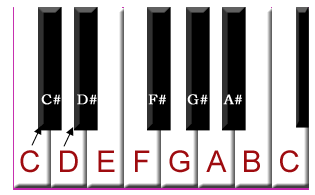
You can see that the E and B notes don’t have a sharp. There is however, a sharp note associate with them. The E# is the same as the F note, and B# is the same as the C note.
Flats:
As well, you can see on the same keyboard we show 5 flats.
Thet are: Db, Eb, Gb, Ab, and Bb.
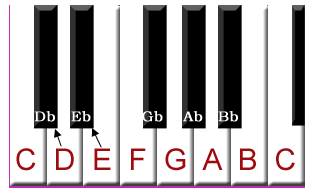
You can see that the F and C notes don’t have a flat. There is however, a flat note associate with them. The Fb is the same as the E note, and Cb is the same as the B note.
Why Not Call Them by Their Simple Note Name?
So why wouldn’t we just call E# a F and B# a C; or Fb an E and Cb a B? Well, you will find that many people do call them by there single note name, but this isn’t correct. At least not in true theory which you will learn when you study music scales.
Remember when we stated above that the definition of sharp and flat was a half step up or down respectively? The reason for this is to consider other musical elements known as the scale and the key signature. The typical major and minor scales each have a note name A through G in the scale.
It only changes starting position depending on what key (aka. key signature) you begin with.
As an extreme example, the C# major scale starts with C#, and continues with D#, E#, F#, G#, A#, and B#.
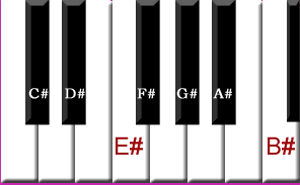
See where we used both the E# and B# and did not duplicate any note names. If we had used F and F# the notes would have been correct but the names would not. We would not have had an E in the scale.
Now be aware there are altered scales that will violate this rule for convenience, but in general we can apply this concept to the basic theory we will learn hear.
What about double sharp and double flat.
The double sharp (x) or double flat (bb) occur when you are already on a named sharp or flat and need to modify it a half step up or down.
Lets say you are playing a note on a chord such as C#, E#, G# and wanted to augment the G# (raise it half step). You would then go from G# to A, but you already have an A note in the scale, so you would have to call it G double sharp (Gx) and it is shown on a treble clef:
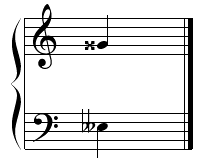
And the E double flat (Ebb) on the bass clef.
This is not a difficult concept, but many people seem to get hung up on the music theory sharps and flats that don’t readily relate to the keyboard where there is no black key. Because the C scale is usually the first one to be taught we also don’t see these odd notes until long into our music lessons.
So there you have the essence of the music theory sharps and flats, with this knowledge you will easily pick up on this concept as you explore the scales and key signatures.

